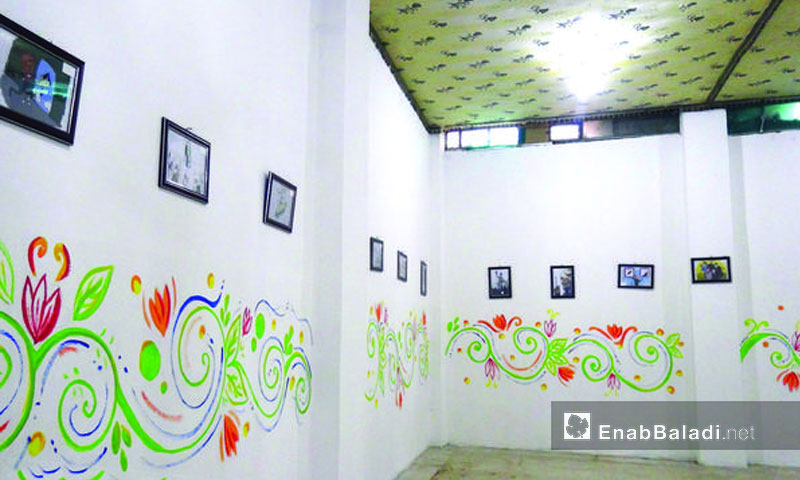None of the people who witnessed the attack on the blood bank in the city of Saraqib in Idlib governorate might have anticipated that one of them will come out to transfer their fear and panic during these violent moments into caricatures about steadfastness and challenge. The bloody assault was all present in the first caricature exhibition which took place from 9 to 12 December.
Among the witnesses was the artist Bilal Musa, who was amazed by the response of the ambulance and civil defence teams who helped the victims immediately after the air raid. In that exhibition, he found a chance to honour the actions of these people, as he told Enab Baladi.
According to Musa, the exhibition which “Syria in Idlib Eyes” campaign has organized, derives its importance from the fact that it brings all the region’s artists together. It is also important because it asserts these artists’ presence and attests for their actions while Idlib is depicted as a military front only. In addition to this, the exhibition is a chance for these artists to conduct cooperative works in the future, ones that would change the stereotypical image of their governorate.
Musa hopes that the exhibition would attract the interest of the concerned bodies to encourage the talented people through a caricature magazine and other projects that can revive this art.
As for the motive which might trigger the interested people to support the field of caricature is this art’s ability to reach the different segments of society and to overcome the challenge which might face the people while trying to understand the idea and meaning behind designs, photos and posters according to Musa. He actually observed this ability in the people’s acceptance of the exhibition since it delivers crucial messages in a light, funny and lovable manner.
One of this art’s aspects is its ability to help the artist and society to discover themselves and the links which connect them together and link them to their homeland. America, for example, considers the Statue of Liberty as the symbol which represents its identity. Similarly, Musa sees the paramedics and the White Helmets as the symbol of Syria today and that is what he tried to show in his painting called the “Syrian Statue of Liberty.” Through the painting, he manifested the steadfastness of the paramedics despite the destruction surrounding them. On the wall, alongside this painting, another drawing stood depicting “Hazem’s” weary face, the face of one of the Civil Defense’s effective members in Saraqib.
Even though the exhibition is the first of its kind in an area that suffers from difficult living and security conditions, the popular interest in seeing this experience was remarkable for the exhibitors, despite the varying intensity of attendance at different times.
According to the exhibition’s coordinator, Rawad Razaz, “Syria in Idlib Eyes” campaign discovered the presence of a number of talented young people in the opposition-held regions, who were suppressed due to the circumstances that surrounded them. This situation inspired the exhibition, one of many projects that include poetry and cinema, which sought to introduce, develop and motivate these talents and to encourage other young people to discover their talents. This in its turn would play a role not only in changing Idlib’s image, but also in changing the adjective that accompanied it during the reign of Bashar al-Assad, as one of the “forgotten cities.”
In an interview with Enab Baladi, Mohammad al-Khani, from Saraqib, expressed his joy over the experience, which the city was in need for. He hopes that the city and other parts of Idlib would witness more of these activities in the future.
The attendees interacted positively with the paintings that represented the steadfastness of the paramedics and the drawings which once again demanded attention to the detainees’ sufferings, especially that they are actually in need for someone to transfer their voices from the depths of the darkness enveloping detention centers, according to some visitors.
The exhibition involves a voting process through which the best painting would be chosen. The owner of the painting will receive an award for his effort. Mohammad, one of the exhibition’s attendees, pointed out that the paintings were only numbered and no names were added, which he considered as a step to support transparency during the voting process that will evaluate the content regardless of the painter.
The painting which depicted Syria as drowning in water, with only a small part appearing on the surface, representing northern Syria, according to Mohammad, was the best painting in the exhibition.
Enab Baladi came across some visitors from the city of Ariha, who said that some visitors thought that the paintings did not live up to the required level, which prevented people from coming to the exhibition from towns and cities around Saraqib to support the emerging talents or buy some of their works.
Some fans and followers hope that the art of caricature would witness a revival in Idlib’s society, as it is the closest art to the popular culture, and is entrusted with the task of criticizing the political and social authorities.
